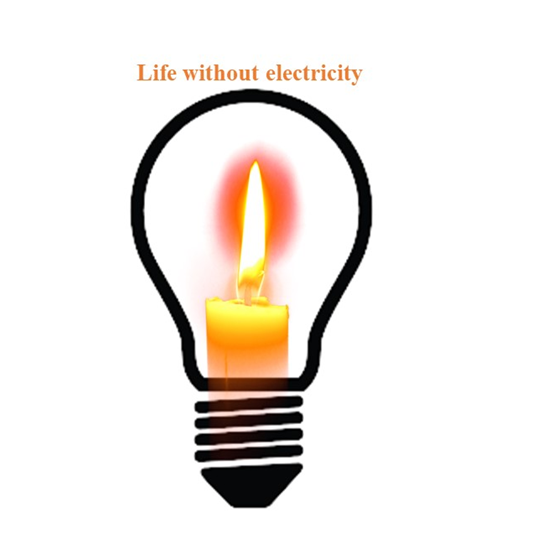Electricity (The transfer of energy)
Electricity.., the most common word that we hear in our day-to-day life. Though it is not visible to us, we feel incomplete in the absence of it. Our lives would be impossible to imagine without electricity. That is the impact it has on our lifestyle. Even our environment is related to electricity in the form of lightning and thundering. Regardless of its physical existence, there exists a principle in science behind it.
Electricity is a
physical phenomenon that is associated with the matter and motion of charges
present in it. Electricity and magnetism are relative phenomena of
electromagnetism. Electricity is dependent on the presence of an electric
charge (positive or negative) in matter, which produces an electric field. So,
as electricity is defined as the motion of an electric charge in a particular
direction, it causes an electric current and it produces a magnetic field.
Notably, only negative charges (referred to as electrons) are responsible for
the generation of electric current.
Electricity is of two
kinds, viz., static electricity and dynamic electricity. We learned in atomic
structure that an atom is neutral, with an equal number of protons and neutrons
in its nucleus and electrons revolving around the nucleus in their fixed
orbits. Under normal conditions, protons (referred to as positive charges)
balance out electrons (referred to as negative charges) as they are equal in
number. However, as per electron flow, some atoms are capable of attracting
electrons while some are capable of losing electrons. Electrons in the outer
orbits (known as valence electrons) of atoms are freely available (i.e., less
strongly attracted to protons in the nucleus) and are, as such, called free
electrons. When an external force (which is greater than the force of
attraction between the electron in the valence band and the proton in the
nucleus), these electrons are ready to be free from the atoms, and a steady
stream of force on the electron tends to transfer its energy to the valence
electron present in its neighbouring atom, and the process continues. Each of
these electrons forms an electric current. Based on their ability to lose or
gain electrons, the electrical conducting materials have been classified into
conductors, semiconductors, and insulators.
We are familiar with the word
"static," which means "stationary or fixed." In brief,
insulators are those which are not capable of losing electrons (i.e., the force
of attraction between valence electron and nucleus is very high). As a result,
electrons in the insulators will not transfer energy to their adjacent atoms,
and no electric current is produced. Under certain conditions, the charge from
a substance may be transferred to the other substance, which includes
contact-induced separation, heat-and-pressure-induced separation, and
charge-induced separation. We are familiar with the word "static,"
which means "stationary or fixed." In brief, insulators are those
which are not capable of losing electrons (i.e., the force of attraction
between valence electron and nucleus is very high). As a result, electrons in
the insulators will not transfer energy to their adjacent atoms, and no
electric current is produced. Under certain conditions, the charge from a
substance may be transferred to the other substance, which includes
contact-induced separation, heat-and-pressure-induced separation, and
charge-induced separation.
- Contact-induced
separation includes when two insulators rub against each other; since
their surfaces are in contact, a chemical bond forms in between them known
as adhesion, due to which a frictional force appears.
- Heat
induced separation includes when an insulator material is heated up, the
separation of charges occurs in the atoms.
- Pressure-induced
separation occurs in a few materials, including crystals and ceramics, and
occurs when molecules are subjected to pressure.
- Charge-induced
separation: when a charged material is brought near a neutral one, the
unlike charges inside the neutral object attract while like charges repel.
When the insulators
are subjected to the above factors, the imbalance of the charges occurs in the
insulators and, thereby, electrical current is produced. For example, if you
take the plastic ruler and take it near to the churned paper, nothing happens.
And when the same plastic ruler is rubbed continuously on a surface, the
churned paper now sticks to the ruler. Here, the attraction of charges can be
felt. The substance that loses electrons becomes positively charged and the
substance that gains electrons becomes negatively charged. These charges are
stationary and remain on the surface of the substance. Since there is no flow
of electrons, this is referred to as static electricity. And this is known as
static electricity.
On the other hand,
metals, which are capable of losing electrons (i.e., the force of attraction
between valence electron and nucleus is very high), allow their electrons to
freely transfer their energy to their neighbouring atom electrons, such that an
electric current is produced, which is dynamic. If the transfer of energy is in
a single direction, then it is called direct current (DC), and if the direction
of transfer of energy alters instantaneously, then it is called alternating
current (AC). This type of electricity is known as "dynamic electricity,"
which is supplied to our utility.


Comments
Post a Comment